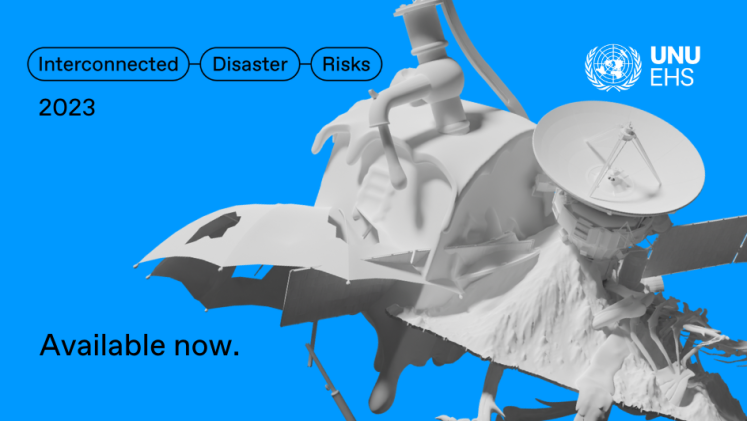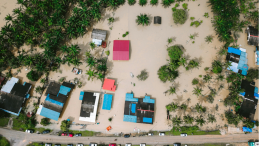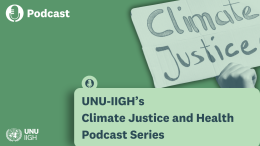Bonn, Germany 25 October – A United Nations University report released today finds that drastic changes are approaching if risks to our fundamental socioecological systems are not addressed.
The Interconnected Disaster Risks report 2023 published by the United Nations University – Institute for Environment and Human Security (UNU-EHS) warns of six risk tipping points ahead of us:
- Accelerating extinctions
- Groundwater depletion
- Mountain glaciers melting
- Space debris
- Unbearable heat
- Uninsurable future
Systems are all around us and closely connected to us: ecosystems, food systems, water systems and more. When they deteriorate, it is typically not a simple and predictable process. Rather, instability slowly builds until suddenly a tipping point is reached and the system changes fundamentally or even collapses, with potentially catastrophic impacts.
A risk tipping point is defined in the report as the moment at which a given socioecological system is no longer able to buffer risks and provide its expected functions, after which the risk of catastrophic impacts to these systems increases substantially. These diverse cases illustrate that risk tipping points extend beyond the single domains of climate, ecosystems, society or technology. Instead, they are inherently interconnected, and they are also closely linked to human activities and livelihoods.
Many new risks emerge when and where our physical and natural worlds interconnect with human society. One example of a risk tipping point that the report explains is groundwater depletion. Underground water reservoirs called aquifers are an essential freshwater resource around the world, and they supply drinking water to over 2 billion people. Around 70 per cent of groundwater withdrawals are used for agriculture, oftentimes when there is not sufficient water from above-ground sources available. Today, aquifers help to mitigate half of the losses in agriculture caused by drought, a phenomenon which is only expected to increase in the future due to climate change. But the report warns that now it’s the aquifers themselves that are approaching a tipping point: More than half of the world’s major aquifers are being depleted faster than they can be naturally replenished. If the water table falls below a level that existing wells can access, farmers can suddenly find themselves without the ability to access water, which puts entire food production systems at risk of failure. Some countries, such as Saudi Arabia, have already surpassed this groundwater risk tipping point; others, like India, are not far from it.
“As we indiscriminately extract our water resources, damage nature and biodiversity, and pollute both Earth and space, we are moving dangerously close to the brink of multiple risk tipping points that could destroy the very systems that our life depends on,” said Dr. Zita Sebesvari, Lead Author of the Interconnected Disaster Risks report and Deputy Director of UNU-EHS. “Additionally, we also lose some of our tools and options to deal with future disaster risk.”
The analysis reveals that the cases share similar root causes and drivers which are embedded in our actions and behaviours that increasingly put pressure on our systems until they are pushed to the brink of collapse. Reaching these points means new risks will be introduced, many of which we do not yet know of.
“As we approach these tipping points, we will already begin to experience the impacts. Once crossed, it will be difficult to go back,” warned Dr. Jack O’Connor, Lead Author and Senior Expert at UNU-EHS. “Our report can help us see risks ahead of us, the causes behind them and the urgent changes required to avoid them.”
The report does not just define and identify risk tipping points, but it also proposes a new framework to avoid or mitigate the consequences. Solutions fall into two categories: Avoid solutions, which target root causes and drivers of risk to avoid risk tipping points altogether, and Adapt solutions, which help prepare or better address the negative impacts of risk tipping points if they cannot be avoided.
For both Avoid and Adapt solutions, there are two type of actions. Delay actions work within the existing “business as usual” system and aim to slow down the progression toward risk tipping points or the worst impacts. But the ideal action is to Transform, which involves a fundamental reimagining of a system into something stronger and more sustainable than before.
In the case of the “Unbearable heat” risk tipping point described in the report, it is human-induced climate change that is causing a global rise in temperatures, leading to more frequent and intense heatwaves that will in some areas reach temperatures in which the human body can no longer survive. An Adapt-Delay solution would aim to counteract this risk by installing air conditioners, for example. The air conditioners will delay when the risk tipping point is reached for the people in the area, but will not address the heat itself. An Avoid-Transform solution, on the other hand, would aim to halt the emissions of greenhouse gases and at the same time drive societal change toward low-carbon ways of living so the tipping point can ultimately be avoided.
The report finds that solutions being implemented today tend to focus on Delay rather than Transform, although increasing focus is being put on transformative change to achieve global goals on transitioning to a more sustainable future. It will require more game-changing solutions to move us away from a future of multiplying risk tipping points.
Transformative solutions will also require considerable societal and personal effort, and the report highlights overall changes we can each make to our behaviours and values.
“Real transformative change involves everyone,” said Sebesvari. “The report serves as a timely reminder before the UN Climate Conference that we must all be part of the solution.”
###
Notes to Editors
Images and videos available here.
Courtesy translations of this media release available in Spanish and German are available here.
Short summaries of the 6 risk tipping points can be found here.
Technical background reports on each tipping point are available here.
Press release in English, Spanish, German available.
For more information or to arrange an interview, please contact:
Dr. Nadine Hoffmann
Head of Communication
United Nations University Institute for Environment and Human Security
Phone: + 49 151 2672 1390 (mobile)
n.hoffmann@vie.unu.edu
Austin Gonzales
Senior Communications Assistant
United Nations University Institute for Environment and Human Security
Phone: + 49 228 815 0276 (landline)
gonzales@vie.unu.edu
www.ehs.unu.edu
About the Interconnected Disaster Risks Report (#InterconnectedRisks)
Interconnected Disaster Risks is an annual science-based report designed to be accessible for the general public. It is published by the United Nations University – Institute for Environment and Human Security, and was first released in 2021. The idea for the report was developed based on the recognition that disasters are occurring at an ever-faster rate and, despite progress being made in how we prepare and respond to them, we are continuously being caught out by new extremes and new emerging threats. The report analyses several concrete examples of disasters each year and explains how they are inter- connected with each other and with human actions. It seeks to shed light on the interconnections that might otherwise be missed, and describes how we can develop solutions to use these connections to our advantage. The report is based on thorough scientific analysis and includes technical background reports for each of the cases, which together with the main report and executive summary are made available on interconnectedrisks.org
About the United Nations University, Institute for Environment and Human Security (UNU-EHS)
Based in Bonn, Germany, UNU-EHS conducts research on risks and adaptation related to environmental hazards and global change. The institute’s research promotes policies and programmes to reduce these risks, while taking into account the interplay between environmental and societal factors. Research areas include climate change adaptation by incorporating insurance-related approaches, environmentally- induced migration and social vulnerability, ecosystem-based solutions to adaptation and disaster risk reduction, and models and tools to analyse vulnerability and risks linked to natural hazards, with a focus on urban space and rural-urban interfaces.UNU-EHS also offers the joint Master of Science degree programme “Geography of Environmental Risks and Human Security” with the University of Bonn and hosts international PhD projects and courses on global issues of environmental risks and sustainable development. http://ehs.unu.edu/




